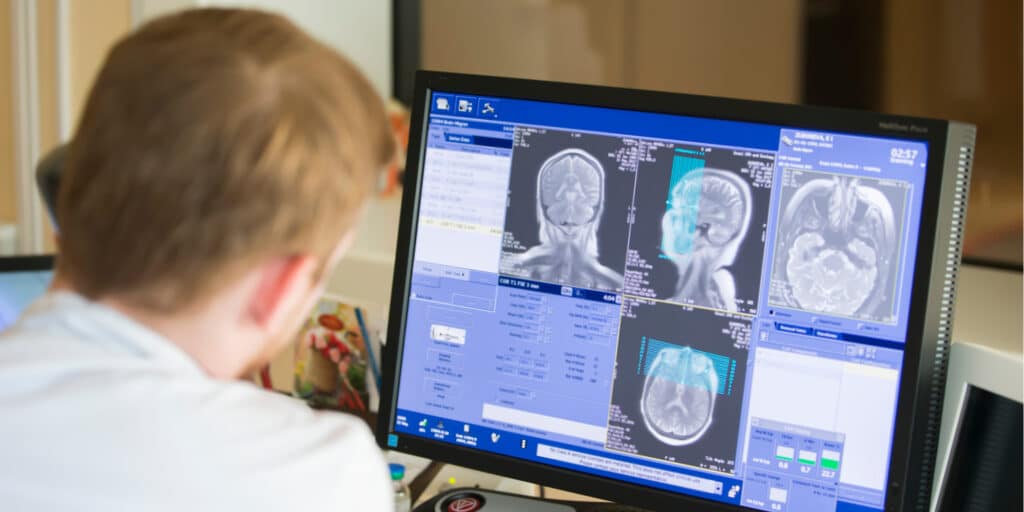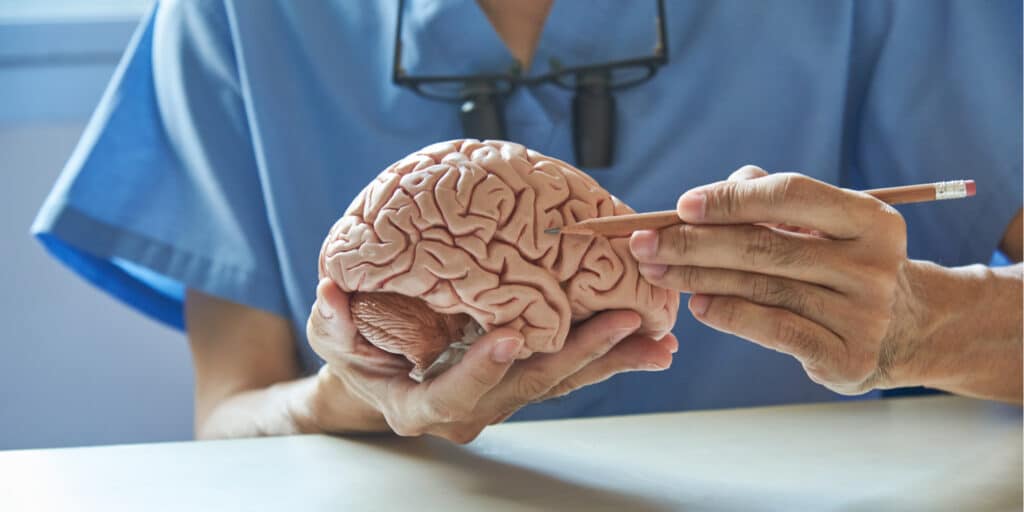A patient with amyotrophic lateral sclerosis (ALS), who has been left completely paralyzed and unable to communicate, has spoken his first words in months using a brain implant. His first words? He asked his caregivers for a beer. Composing sentences at a rate of just one character per minute, the 36-year-old, who has remained nameless, also asked to listen to the band Tool “loud,” requested a head massage from his mother, and ordered a curry for dinner – all through the power of thought. The research and findings were detailed in a study published in the journal, Nature Communications, earlier this week.
To better understand how this brain implant helped this ALS patient communicate, it’s important to first understand what ALS is, and how it can render someone unable to communicate.
Understanding How ALS Can Lead to Paralysis

Commonly referred to as Lou Gehrig’s disease, after the famous baseball player, ALS is a rare neurodegenerative disease that has no known cure. The disease destroys the nerve cells that control voluntary muscle movement, and will eventually render patients wheelchair-dependent, and even paralyzed in more severe cases.
ALS damages motor neurons in the brain and spinal cord. Motor neurons are nerve cells that control muscle movement. There are two main types of motor neurons: upper and lower. Upper motor neurons send messages from the brain to the spinal cord, and lower motor neurons send messages from the spinal cord to the muscles. Both of these motor neurons are an important part of the body’s neuromuscular system.
Over time, ALS causes the motor neurons in the brain and spinal cord to shrink and disappear, so that the muscles no longer receive signals to move. As a result, the muscles get smaller and weaker. Gradually the body becomes paralyzed, which means that the muscles no longer work.
Even in some of the most severe cases, however, someone with ALS can still see, hear, smell, and feel touch. Even in muscles that become paralyzed, the nerves that carry feelings of hot, cold, pain, and pressure, are not affected by ALS.
Until now, a brain implant has not been tested on a completely locked-in patient, and it was not known whether communication was even possible for people who had lost all voluntary muscular control.
“Ours is the first study to achieve communication by someone who has no remaining voluntary movement and hence for whom the BCI is now the sole means of communication,” said Dr. Jonas Zimmermann, a senior neuroscientist at the Wyss Center.
About the Brain Implant
In March of 2019, the man, then 34, had two square electrode arrays surgically implanted into his brain to facilitate communication after being left in a locked-in state as a result of his ALS. The term “locked-in” is used to describe a rare neurological disorder associated with some progressive cases of ALS. Also known as locked-in syndrome, it refers to patients who no longer have any voluntary control of their body’s muscles, with the exception of eye movement.
“This study answers a long-standing question about whether people with complete locked-in syndrome – who have lost all voluntary muscle control, including movement of the eyes or mouth – also lose the ability of their brain to generate commands for communication,” said Zimmerman.
Working with researchers at the Wyss Center for Bio and Neuroengineering in Geneva, Switzerland, the ALS patient consented to having the brain implant fitted when he still had the ability to use eye movement to communicate in 2018.
“Speaking” with the Brain Implant


After nearly three months of trial and error, a configuration was finally achieved that allowed the patient to use brain signals to communicate. The device worked by allowing the patient to use a binary “yes” or “no” response when presented with letter prompts. For example, when presented with the letter “F” the patient could respond “yes” or “no” to put together words and sentences.
It took the patient nearly three weeks to produce his first sentences, and over the following year, he had produced dozens of sentences.
One of his earliest communications concerned his care, asking for his head to be kept in an elevated and straight position when there were visitors in the room. He also requested different kinds of food to be fed through his tubes, including goulash soup and sweet pea soup. “For food, I want to have curry with potato then Bolognese and potato soup,” one request stated. He was also able to interact with his 4-year-old son and wife, generating the message: “I love my cool son.”
The study noted that the BCI communication system can be used in a patient’s home, with some sessions even being performed remotely via the patient’s laptop.
The scientists behind the brain-computer interface technology are now seeking funding to provide similar implants for other people with ALS, which will cost close to $500,000 over the first two years of use.
“This is an important step for people living with ALS who are being cared for outside the hospital environment,” said George Kouvas, chief technology officer at the Wyss Center. “This technology, benefiting a patient and his family in their own environment, is a great example of how technological advances in the BCI field can be translated to create [a] direct impact.”
Have You Heard of This Brain Implant For Paralyzed ALS Patients?
Let us know in the comments section below!
What topics related to ALS should we cover next?
Email us your ideas at info@painresource.com, we may just feature yours in a future article!
Are you caring for someone with ALS or a similar neurodegenerative disease? Looking for a support group?





My grandma has Lou Gehrig’s disease, she is about 75 years old it was diagnosed 2 years ago. Right now it’s getting more difficult to live for her, because of stiff muscles she can’t even move. Riluzole and Edaravone medicines are given, but won”t give much relief. She can”t eat food without choking. I thought this might be the last stage and the medications she was given did not help at all, so I started to do alot of research on natural treatments, I was introduced to Health Natural Centre and their ALS Herbal Protocol. She started on the ALS/MND Treatment last year, her symptoms gradually diminished including her vocal cord spasm, Body Weakness and Difficulty with swallowing. She is getting active again since starting this treatment, she is able to walk again ( down the street and back )she have also resumed exercising to strengthen muscles!! God Bless all ALS Caregivers. Stay Strong, take small moments throughout the day to thank yourself, to love your self, and pray to whatever faith, star, spiritual force you believe in and ask for strength. I can personally vouch for these remedy but you would probably need to decide what works best for you.
This was great, I have been researching for a while now, and I think this has helped. Have you ever come across Health Natural Centre ALS disease HERBAL FORMULA (just google it). It is a smashing one of a kind product for reversing Lou Gehrig’s disease completely. Ive heard some decent things about it and my buddy got amazing success with it.